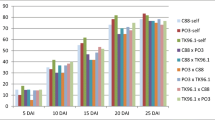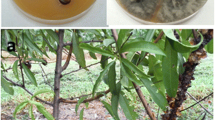Summary
Neotuberosum clones with differing levels of resistance toFusarium coeruleum andFurarium sulphureum, and putative resistance toPhytophthora infestans, were selected and used in crosses with Tuberosum clones. The resulting progenies were assessed for their resistance to each of these pathogens and for breeders' preference. There was little correlation between disease scores for the twoFusarium species (r=0.21 and 0.34 for the Neotuberosum and hybrid clones respectively), indicating that resistance to each species is distinct. Statistical analyses revealed differences between the Neotuberosum parents and between the Tuberosum parents for all traits, but the Neotuberosum differences for late blight were not significant (P=0.10–0.05) when tested against the interaction between the two sets of parents. The interaction was significant forF. coeruleum and breeders' preference, but notF. sulphureum. No reciprocal differences were found. The only statistically significant correlation between traits for the 72 progenies was a small one (r=0.33; P=0.01–0.001) between the twoFusarium species; for all other pairs of traits r was less than 0.10.
It is concluded that there are good prospects for combinding resistances to the twoFusarium species from different sources and also for achieving high levels of other desirable characteristics.
Similar content being viewed by others
References
Bradshaw, J.E., H.E. Stewart, R.L. Wastie, M.F.B. Dale & M.S. Phillips, 1995. Use of seedling progeny tests for genetical studies as part of a potato (Solanum tuberosum subsp.tuberosum) breeding programme.Theoretical and Applied Genetics 90: 899–905.
Brown, J., P.D.S. Caligari, M.F.B. Dale, G.E.L. Swan & G.R. Mackay, 1988. The use of crossprediction methods in a practical potato breeding programme.Theoretical and Applied Genetics 76: 33–38.
Desjardins, A.E., E.A. Christ-Harned, S.P. McCormick & G.A. Secor, 1993. Population structure and genetic analysis of field resistance to thiabendazole inGibberella pulicaris from potato tubers.Phytopathology 83: 164–170.
Glendinning, D.R., 1981. Evaluate Neo-Tuberosum potatoes as parental material for use in breeding cultivars. Scottish Crop Research Institute Annual Report 1981, pp. 181–183.
Glendinning, D.R., 1987. Neo-tuberosum. Scottish Crop Research Institute Annual Report 1987, pp. 77–78.
Hanson, L.E., S.J. Schwager & R. Loria, 1996. Sensitivity to thiabendazole inFusarium species associated with dry rot of potato.Phytopathology 86(4): 378–384.
Hawkes, J.G., 1990. The Potato: Evolution, Biodiversity and Genetic Resources. Bellhaven Press, London.
Hide, G.A., P.J. Read & S.M. Hall, 1992. Resistance to thiabendazole inFusarium species isolated from potato tubers affected by dry rot.Plant Pathology 41: 745–748.
Jellis, G.J. & N.C. Starling, 1983. Resistance to powdery dry rot (Fusarium sulphureum) in potato tubers.Potato Research 26: 295–301.
Langerfeld, E., 1979. Prüfung des Resistenzverhaltens von Kartoffelsorten gegenüberFusarium coeruleum (Lib.) Sacc. Potato Research 22: 107–122.
Leach, S.S. & R.W. Webb, 1981. Resistance of selected potato cultivars and clones to Fusarium dry rot.Phytopathology 71(6): 623–629.
Simmonds, N.W., 1969. Prospects for potato improvement. Scottish Plant Breeding Station Forty-Eighth Annual Report 1968-69, pp. 18–38.
Stewart, H.E., K. Taylor & R.L. Wastie, 1983. Resistance to late blight in foliage (Phytophthora infestans) of potatoes assessed as true seedlings and as adult plants in the glasshouse.Potato Research 26: 363–366.
Wastie, R.L. & J.E. Bradshaw, 1993. Inheritance of resistance toFusarium spp. in tuber progenies of potato.Potato Research 36: 189–193.
Wastie, R.L. & J.E. Bradshaw, 1995. Comparison of resistance toFusarium spp. of glasshouse-and field-grown tuber progenies of potato.Potato Research 38: 345–351.
Wastie, R.L. J.E. Bradshaw & H.E. Stewart, 1993. Assessing general combining ability for late blight resistance and tuber characteristics by means of glasshouse seedling tests.Potato Research 36: 353–357.
Wastie, R.L., P.D.S. Caligari, H.E. Stewart & G.R. Mackay, 1988. Assessing the resistance to gangrene of progenies of potato (Solanum tuberosum L.) from parents differing in susceptibility.Potato Research 31: 355–365.
Wastie, R.L., Helen E. Stewart & J. Brown, 1989. Comparative susceptibility of some potato clones to dry rot caused byFusarium sulphureum andF. solani var.coeruleum.Potato Research 32: 49–55.
Author information
Authors and Affiliations
Rights and permissions
About this article
Cite this article
Lees, A.K., Bradshaw, J.E. & Stewart, H.E. Inheritance of resistance toFusarium spp. and toPhytophthora infestans in crosses between Neotuberosum and Tuberosum potatoes estimated by seedling tests. Potato Res 41, 267–275 (1998). https://doi.org/10.1007/BF02358196
Accepted:
Issue Date:
DOI: https://doi.org/10.1007/BF02358196




